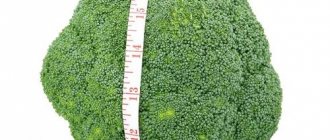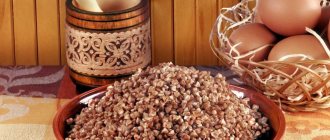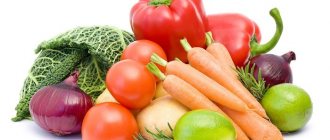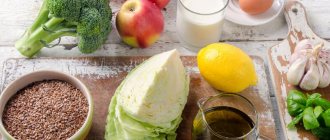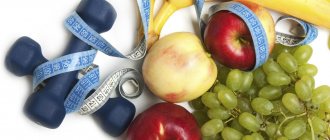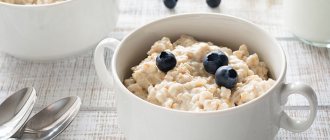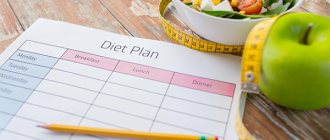Any diet involves some restrictions. They contribute to the formation of restrictive eating behavior. People with this type of eating behavior are literally obsessed with all kinds of diets and food restrictions. Their desire to lose weight is based on the sacred belief that by counting calories and reducing their daily intake to a minimum, they can lose significant weight. Indeed, losing extra pounds on restrictive diets is not that difficult.
The Czech diet was developed by nutritionist Dr. Horvath. The diet lasts 3 weeks and helps you lose up to 15 kg of excess weight. The entire diet consists of low-fat and low-calorie foods, and is strictly prescribed by the amount of food taken and by day.
This diet is designed for relatively slow weight loss and long-term retention of results, so if you adhere to all the nuances and features of Dr. Horvath’s regimen, the weight already lost will not return after leaving the diet. Although the number of calories consumed is quite small, thanks to a balanced set of foods, eating the Czech diet eliminates the torment of hunger and an empty stomach. Low-fat protein foods, fruits and vegetables are the main components of the diet according to this system.
What is the Horvath Diet?
The nutritional system for losing weight according to Dr. Horvath has an advantage over other diets - it is the absence of a feeling of hunger in the person losing weight . You can eat allowed low-calorie foods, and the number of meals per day is 5-6. It will be difficult for those with a sweet tooth to stay on such a diet - sugar and dishes containing it are among the prohibited foods. The total calorie content of food that can be eaten per day is not reduced critically - on average it is 1500 - 1700 kilocalories.
Diet for ankylosing spondylitis
Often, when a person feels some kind of incomprehensible pain in the joints, his first thought is “ joint bruise.”
, more likely". But, unfortunately, everything can be much worse, for example – inflammation. If the patient has already been examined and knows his diagnosis, you can think about choosing the right diet.
Necessary vegetables and fruits
The largest amount of important vitamins and minerals enters the body thanks to healthy vegetables and fruits. This is considered the best alternative to any packaged or canned food.
It is worth noting the biggest advantages of eating fruits and vegetables:
- Low calorie content;
- High nutritional value;
- A large number of microelements and vitamins.
Including the right amount of fresh, healthy foods in your diet is not difficult. This can be either a hearty vegetable soup or a light breakfast, for example, fresh berries or cottage cheese with bananas.
In case of damage to the intestinal mucosa, it is recommended to consume bananas and yoghurts along with NSAIDs (anti-inflammatory drugs).
Omega-3 element
Provisions that contain Omega-3 can reduce the degree of complications caused by ankylosing spondylitis. Sometimes this element is replenished in the body by using special supplements.
There are many foods containing fatty acids. The main ones:
- Walnuts
- Legumes;
- Flaxseeds;
- Soybean, linseed, rapeseed oils;
- Fish (such as mackerel or salmon)
Just because some vegetables do not contain or have low amounts of Omega-3, this does not mean that they should not be included in the main diet. They are quite rich in other useful substances. These vegetables include:
- Spinach;
- Brussels sprouts;
- Regular white cabbage;
- Salad greens.
Foods containing sugar, salt or fat
All foods that contain a high percentage of sugar, salt or fat, or are highly processed, can cause severe inflammation. In some cases, it is possible to get such inflammations from some dairy products.
To protect yourself from such an outcome, you should stop eating foods packaged in packs and bags. It is strongly recommended to read the ingredients on the labels. It is important to limit yourself from foods that contain a large number of components harmful to the body. Such additives include:
- Sugar and sweeteners;
- Large percentage of salt;
- Hydrogenated oils;
- Preservatives;
- Trans fats (they raise LDL (bad cholesterol) levels and lower HDL (good cholesterol) levels).
Nutritional supplements
If your diet is still lacking nutrients, you can use dietary supplements. But you won’t need them at all if your diet includes fruits rich in vitamins, nuts, beans, and lean meat.
To choose the right dietary supplements, you should definitely consult a doctor, because most manufacturers give false characteristics to their product.
It is also important to remember that some nutritional supplements may be incompatible with medications or their individual components. You should also consult a doctor on this issue; you may have to change the prescription slightly.
Starch in the diet
Most patients suffering from ankylosing spondylitis report improvement in their condition by reducing the dose of starch in a new diet or diet. New studies have not yet yielded definitive results, but most old studies say the same as patients: by limiting yourself to foods containing large amounts of starch, you can reduce the severity of inflammation.
A low-starch diet prohibits some regularly consumed foods. For example:
- Bread;
- Pasta;
- Potato dishes;
- Any baked goods;
- Rice dishes.
But, nevertheless, she encourages the following list of products:
- Vegetables;
- Fruits;
- Eggs;
- Lean meat;
- Milk.
Mediterranean diet
In general, when treating ankylosing spondylitis, there is no specific diet. But the Mediterranean diet fits the bill best. Its big advantage is that it is perfectly balanced, which helps keep your weight normal and, if necessary, gradually lose kilos.
Also, the Mediterranean diet will be a good prevention of other very unpleasant diseases. Literally after a week or two, visual acuity and skin condition will begin to improve. This diet can become your main diet if necessary. The following products are recommended for consumption:
- Olive oil;
- Fish dishes (no more than three to four times a week);
- Dairy provisions;
- Boiled eggs (also no more than four times a week);
- Lean poultry (three times a week).
Such a diet will also be useful for children who become very accustomed to food full of artificial additives. For example, fast food or confectionery.
Tips for switching to a new diet
The first thing you should focus on is to avoid any questionable diets! They can cause a lot of harm and cause the emergence of new diseases (the first symptom of poor nutrition is constant headaches
). It is also very important to discuss in detail with your doctor daily nutrition and the components of the diet, as well as take into account all the medications that the patient takes.
To begin with, to switch to a healthy diet, you just need to follow three very simple rules:
- Drink plenty of water (at least one and a half liters);
- Eat in small portions;
- Chew food slowly and thoroughly;
- Leave all sweets and other unhealthy but tasty foods for special occasions.
Author: K.M.N., Academician of the Russian Academy of Medical Sciences M.A. Bobyr
Advantages
Dr. Horvath's Czech diet is an effective way to lose weight, it is only important to adhere to its rules. Among the advantages of this diet are the following:
- no stress for the body – meals every 2-3 hours, varied menu;
- stable result – after the end of the diet the effect remains;
- weight loss occurs gradually and does not affect the condition of the skin - it does not sag or lose tone;
- a balanced menu is not harmful to health - following a well-thought-out diet, you can get rid of toxins, improve digestion, and achieve improved well-being.
Advantages and disadvantages
| pros | Minuses |
|
|
Disadvantages and contraindications of Dr. Horvath's diet
The diet developed by Dr. Horvath is not suitable for everyone. Some note that the diet has disadvantages:
- Long process of weight loss. Not everyone can stick to proper nutrition for a long period and quit what they started halfway.
- Poor efficiency. Some people who lose weight do not get the expected results - the Horvath diet does not help everyone.
- A diet that strictly limits the consumption of sweets is a painful test for those with a sweet tooth.
- There is no strict menu in this diet - those losing weight need to create their own diet, counting the number of calories.
Diet features
The goal of the Czech diet is not to lose the maximum number of kilograms in a minimum period of time for obvious reasons - the consequences of short-term programs are unpleasant. The system is designed for a long-term weight loss process lasting at least 3 weeks.
The specificity of the diet is that while the calorie content is limited, the diet remains completely balanced. By adhering to the compiled menu, the body receives all the necessary vitamins and microelements. Those who are losing weight do not experience feelings of hunger or malaise throughout the entire period of following the diet.
Doctors all over the world confirm that the Horvath minus 15 kg diet will not harm the body. The approach of the Prague nutritionist ensures that the extra pounds are slowly but surely burned off and will not return after leaving the diet.
Permitted and prohibited products
To adhere to Dr. Horvath's diet, you need to focus on the list of foods that you can eat. Among the permitted ones are the following:
- lean fish, lean meat and meat products (sausages);
- low-fat dairy products (cottage cheese, yogurt, kefir);
- porridge with water;
- vegetables (preferably green) - cabbage, zucchini, broccoli, cucumbers, spinach, greens;
- unsweetened fruits;
- eggs;
- mushrooms;
- butter and sunflower oil;
- bread – rye, crackers, whole grain.
The list of prohibited products is small. It includes dishes, the refusal of which will benefit the body:
- sweets and desserts: Dr. Horvath recommends replacing sugar with xylitol, fructose, honey, stevia;
- fatty meat, lard;
- limit the consumption of salt, marinades and canned food;
- hard cheese, fat content above 50%;
- baked goods, baked goods made from premium flour;
- alcohol.
Czech diet menu
You should organize meals according to the rules of the diet, focusing on preferences - the regime implies some freedom. Dr. Horvath suggests that the daily diet should include three main meals and two to three snacks. A table with an approximate diet for a week will help you create a suitable menu:
| Eating | Monday | Tuesday | Wednesday | Thursday | Friday | Saturday | Sunday |
| Breakfast | Oatmeal (150 ml), a slice of whole grain bread, processed cheese, coffee. | Omelette of 2 proteins with spinach, cabbage salad (100 g), green tea. | Rice milk porridge (150 ml), bread, coffee. | Boiled egg, cucumber, bread, coffee with milk. | Oatmeal with honey (150 ml), processed cheese 50 g), bread. | Cottage cheese casserole with semolina, egg and berries (150 g), green tea. | Apple, orange, crackers, coffee |
| Lunch | Carrot salad with sunflower, olive oil (150 g), apple juice. | Baked apples (2 pcs.), tea with ginger. | Grapefruit (100 – 150 g) | Cabbage salad with tomatoes and cucumbers (150 g), whole grain bread, green tea. | Fruit salad of orange, apple, seasoned with yogurt (150 g). | Vinaigrette (150 g), whole grain bread, tea. | 200 ml milk or kefir. |
| Dinner | Boiled chicken fillet (100 g), stewed vegetables - broccoli, zucchini, carrots (100 g), tea. | Buckwheat porridge (150 g) with steamed turkey meatballs (80 g), compote. | Baked turkey fillet with spices (100 g), vegetable salad (100 g), apple juice. | Ham (100 g) with stewed vegetables, tomato juice. | Steamed chicken cutlets (80 g), boiled potatoes (100 g), fresh herbs, dried fruit compote. | Baked fish with a slice of lemon (100 g), cabbage salad (100 g), bread, tea. | Chicken fillet casserole with vegetables (broccoli, zucchini, carrots), covered in egg-milk sauce (200 g), milk. |
| Afternoon snack | Grapefruit (150 g) or watermelon. | Ham sandwich (50 g), coleslaw. | Mashed potatoes (100 g), soft-boiled egg. | Buckwheat porridge with meat merchant style (150 g), cucumber. | Rice with mushrooms (150 g), cucumber, bread. | Boiled potatoes (100 g), 1 egg omelette with herbs. | Vegetable salad (150 g), bread. |
| Dinner | A glass of yogurt, crackers. | Vinaigrette (150 g), whole grain bread, tomato juice. | Vegetable salad (150 g), bread, compote. | A glass of kefir, 2 crackers. | 2 baked apples, tea. | Oatmeal with milk (150 ml), crackers, jelly. | Boiled egg, salad with tomatoes, cucumbers and herbs (100 g), compote. |
Recipes
Sometimes it's hard to come up with a dish using Dr. Horvath-approved foods. In this case, you can use ready-made recipes based on diet recommendations. The list of ingredients can be changed, seasonings can be added, and salt can be added to taste. According to the rules of the diet, foods can only be subjected to certain types of heat treatment - boiling, stewing, baking, grilling or steaming.
Chicken fillet casserole with vegetables
- Time: 100 minutes
- Number of servings: 4 persons.
- Calorie content of the dish: 152 kcal per serving (150 g).
- Purpose: for lunch or dinner.
- Cuisine: Italian.
- Difficulty: medium.
A bright low-calorie dish can be used not only for a dietary table, but also served to guests. Due to proper baking, chicken fillet becomes juicy, soaked in vegetable juices. Vegetables can be replaced with those found in the refrigerator - add onions, herbs, spinach, zucchini. You should not remove the casserole from the mold immediately after cooking - you should wait a little and cut the already cooled dish.
Ingredients
- chicken fillet – 300 g;
- zucchini – 100 g;
- carrots – 1 pc.;
- broccoli – 100 g;
- chicken egg – 1 pc.;
- milk – 50 ml;
- hard cheese – 20 g.
Cooking method
- Boil the fillet until soft for half an hour, pour boiling water over it. Boil peeled and coarsely chopped vegetables in the resulting broth for 20 minutes.
- Line the pan with parchment paper and heat the oven to 180 degrees.
- Place the fillet chopped in a meat grinder or blender on the bottom of the form.
- Place a layer of similarly chopped vegetables on top.
- Prepare the filling - lightly beat the egg, add milk and grated cheese, add salt, mix well. Pour sauce over casserole.
- Bake for 45 minutes.
Vegetable stew with broccoli and celery
- Time: 120 minutes.
- Number of servings: 4 persons.
- Calorie content of the dish: 167 kcal per serving (200 g).
- Purpose: for dinner.
- Cuisine: Russian.
- Difficulty: easy.
Vegetables stewed under a lid are a source of fiber, which is necessary for removing toxins from the body. The dish is economical and satisfying; it can be served for lunch and dinner. If you exclude potatoes from the ingredients, you can significantly reduce the calorie content (77 kcal will remain in one serving). When serving, vegetables can be sprinkled with finely chopped herbs (dill, parsley, celery).
Ingredients
- potatoes – 500 g;
- broccoli – 150 g;
- celery root – 100 g;
- carrots – 1 pc.;
- onion – 1 pc.;
- small zucchini – 1 pc.;
- white cabbage – 200 g;
- tomato – 100 g.
Cooking method
- Prepare vegetables - peel potatoes, carrots, onions. Pour boiling water over the tomato and remove the skin; young zucchini does not need to be peeled.
- Cut potatoes and celery into cubes with a side of 2 cm, carrots and onions into semicircles. Chop the cabbage, separate the broccoli into florets, cut the tomato into thin slices.
- Place cabbage in a saucepan with thick walls and lightly salt it, then potatoes with celery, onions, carrots, zucchini, broccoli and tomatoes.
- Pour 100 ml of boiling water and simmer over low heat under the lid for 60 minutes, do not stir during cooking.
Baked apples with curd filling
- Time: 30 minutes
- Number of servings: 4 persons.
- Calorie content of the dish: 100 kcal per serving (150 g).
- Purpose: for breakfast or dinner.
- Cuisine: French.
- Difficulty: easy.
Baked apples contain pectin, which is beneficial for the gastrointestinal tract - this substance stimulates digestion. Fruits contribute to the effective absorption of curd filling, a source of calcium. Apples are ideal for dessert or as an independent dish - you can eat them in the morning or enjoy them in the evening. It is advisable to use the varieties “Antonovka” or “Simirenko”.
Ingredients
- apples – 4 pcs.;
- cottage cheese 2% fat – 50 g
- yogurt – 1 tsp;
- honey – 2 tsp;
- butter – 1 tsp.
Cooking method
- Core the apples, leaving the bottom intact.
- Mix cottage cheese with yogurt, you can sweeten it with xylitol or stevia.
- Place the fruit in a baking dish. Fill the cavity inside the apples with the cheese mixture; you can place a small piece of butter on top.
- Bake in the oven at 150 degrees for 15 minutes.
- Pour melted honey over the finished apples.
Reduced toxin levels
The anti-cancer diet includes:
- reducing the amount of toxins consumed
- maintaining cleansing and detoxification processes in the body
- Eating healthy, nutrient-dense foods to support proper functioning of the entire body.
The first step is to reduce or eliminate the following foods to stop the production of toxins and reduce cell-damaging free radicals:
- commercial care and decorative cosmetics.
Anything you ingest or apply to your hair and skin, such as shampoos, makeup, or cleansing gels, can often contain carcinogens. Use environmentally friendly cosmetics (such as those tested by the US Environmental Working Group (EWG)).
- cleaning products for the home.
Of course, dirt always accumulates in rooms. You can reduce toxin levels by using more natural cleaning products (or even making your own) that don't contain chemicals.
- unnecessary medications.
All medications affect the liver. Heavy acetaminophen use is now increasingly becoming the leading cause of liver disease, surpassing even alcohol. Talk to your GP and you may be able to reduce the amount of medication you take.
- Plastic.
Ingredients found in plastic containers, packaging and cartons can release substances that are detrimental to the neuroendocrine system. This happens especially often when plastic is heated, so you should not heat food in containers, store hot food in them, or leave water bottles in the sun (for example, in a car).
Even if you eat a healthy diet, toxins can lurk at every turn. Intermittent fasting also promotes detoxification.
The organs responsible for removing toxins and waste from the body (skin, respiratory system, kidneys, liver, digestive system) are often “overloaded”. As a result, some of the toxins end up in the blood. By practicing body cleansing every few months, you can help your organs “catch” and remove toxins from cells and tissues. Various herbs, green drinks, easily digestible foods (such as vegetable juices) or lightly processed foods can help cleanse the intestines and liver.
Some experts recommend drinking alkaline water, which can be made by adding lime or lemon juice to regular water. To cleanse the body, you should also increase your consumption of raw foods and green juices.
While fiber plays an important role in digestion, elimination and detoxification, and is a source of probiotics, too much fiber can be detrimental to a weakened or overactive immune system. Drinking juices, steamed or raw foods, and reducing whole grains in the diet promote easy digestion and rapid absorption of nutrients.
